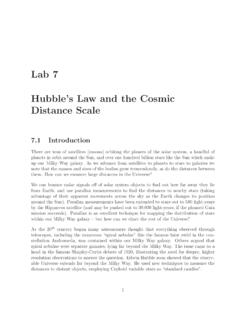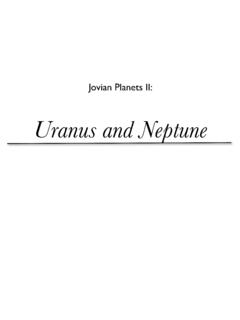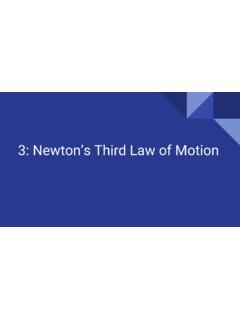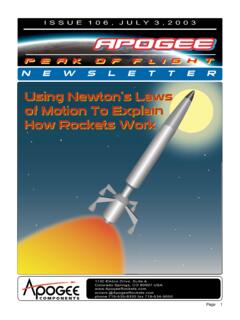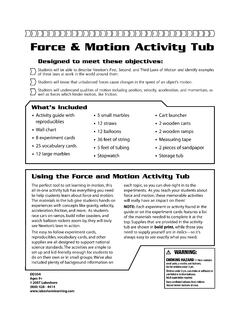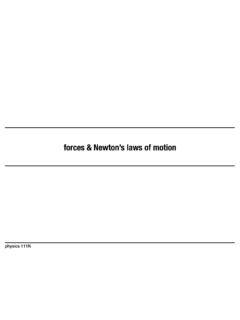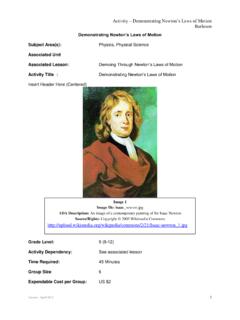Transcription of Laws of Motion: Galileo and Newton
1 laws of motion : Galileo and NewtonGalileo GalileiGalileo Galilei (1564-1642) was a pivotal figure in the development of modern astronomy, both because of his contributions directly to astronomy, and because of his work in physics and its relation to astronomy. He provided the crucial observations that proved the Copernican hypothesis, and also laid the foundations for a correct understanding of how objects moved on the surface of the earth (dynamics) and of , who was born the same year that Galileo died, would build on Galileo 's ideas to demonstrate that the laws of motion in the heavens and the laws of motion on the earth were one and the same.
2 Thus, Galileo began and Newton completed a synthesis of astronomy and physics in which the former was recognized as but a particular example of the latter, and that would banish the notions of Aristotle almost completely from could, with considerable justification, view Galileo as the father both of modern astronomy and of modern : motion of objectsThe heavy metaphysical underpinning of Kepler's laws , combined with an obscure style and a demanding mathematics, caused most contemporaries to ignore his discoveries. Even his Italian contemporary Galileo Galilei, who corresponded with Kepler and possessed his books, never referred to the three laws .
3 Instead, Galileo provided the two important elements missing from Kepler's work: a new science of dynamics that could be employed in an explanation of planetary motion , and a staggering new body of astronomical observations. The observations were made possible by the invention of the telescope in Holland and by Galileo 's ability to improve on this instrument without ever having seen the original. Thus equipped, he turned his telescope skyward, and saw some spectacular made extensive contributions to our understanding of the laws governing the motion of objects. The famous Leaning Tower of Pisa experiment may be apocryphal.
4 It is likely that Galileo himself did not drop two objects of very different weight from the tower to prove that (contrary to popular expectations) they would hit the ground at the same time. However, it is certain that Galileo understood the principle involved, and probably did similar experiments. The realization that, as we would say in modern terms, the acceleration due to gravity is independent of the weight of an object was important to the formulation of a theory of gravitation by and the Leaning TowerNature of gravity: the acceleration due to gravity is independent of the weight of an objectIt is also worth noting that Galileo later went on to conclude that based on this initial premise of inertia, it is impossible to tell the difference between a moving object and a stationary one without some outside reference to compare it against[8].
5 This observation ultimately came to be the basis for Einstein to develop the theory of Special object persists in its state of rest, or uniform motion (in a straight line); unless, it is compelled to change that state, by forces impressed on and the Concept of InertiaIsaac Newton (1642-1727) Newton , Sir Isaac (1642-1727), mathematician and physicist, one of the foremost scientific intellects of all time. Born at Woolsthorpe, near Grantham in Lincolnshire, where he attended school, he entered Cambridge University in 1661; he was elected a Fellow of Trinity College in 1667, and Lucasian Professor of Mathematics in 1669.
6 He remained at the university, lecturing in most years, until 1696. Of these Cambridge years, in which Newton was at the height of his creative power, he singled out 1665-1666 (spent largely in Lincolnshire because of plague in Cambridge) as "the prime of my age for invention". During two to three years of intense mental effort he prepared Philosophiae Naturalis Principia Mathematica (Mathematical Principles of Natural Philosophy) commonly known as the Principia, although this was not published until 1687. in 1696 he had moved to London as Warden of the Royal Mint. He became Master of the Mint in 1699, an office he retained to his death.
7 He was elected a Fellow of the Royal Society of London in 1671, and in 1703 he became President, being annually re-elected for the rest of his life. His major work, Opticks, appeared the next year; he was knighted in Cambridge in 1705. Newton became the most highly esteemed natural philosopher in Europe. He was buried with great pomp in Westminster Abbey. Newton was modest, diffident, and a man of simple tastes. He never married and lived modestly. He was angered by criticism or opposition, and harboured resentment; he was harsh towards enemies but generous to friends. In government, and at the Royal Society, he proved an able and life: Religion: Newton also wrote on Judaeo-Christian prophecy, whose decipherment was essential, he thought, to the understanding of God.
8 His book on the subject, which was reprinted well into the Victorian Age, represented lifelong study. Its message was that Christianity went astray in the 4th century AD, when the first Council of Nicaea propounded erroneous doctrines of the nature of Christ. The full extent of Newton 's unorthodoxy was recognized only in the present century: but although a critic of accepted Trinitarian dogmas and the Council of Nicaea, he possessed a deep religious sense, venerated the Bible and accepted its account of creation. In late editions of his scientific works he expressed a strong sense of God's providential role in nature.
9 Alchemy and mysticism:He left a mass of manuscripts on the subjects of alchemy and chemistry, then closely related topics. Most of these were extracts from books, bibliographies, dictionaries, and so on, but a few are original. He began intensive experimentation in 1669, continuing till he left Cambridge, seeking to unravel the meaning that he hoped was hidden in alchemical obscurity and mysticism. He sought understanding of the nature and structure of all matter, formed from the "solid, massy, hard, impenetrable, movable particles" that he believed God had created. The Calculus: Priority DisputeNewton had the essence of the methods of fluxions by 1666.
10 In 1668 his method of integration by infinite series became know to some other scientists. In Paris in 1675 Gottfried Wilhelm Leibniz independently evolved the first ideas of his differential calculus, outlined to Newton in 1677. Newton had already described some of his mathematical discoveries to Leibniz, not including his method of fluxions. In 1684 Leibniz published his first paper on the 1690s Newton 's friends proclaimed the priority of Newton 's methods. Supporters of Leibniz asserted that he had communicated the differential method to Newton , although Leibniz had claimed no such thing.
